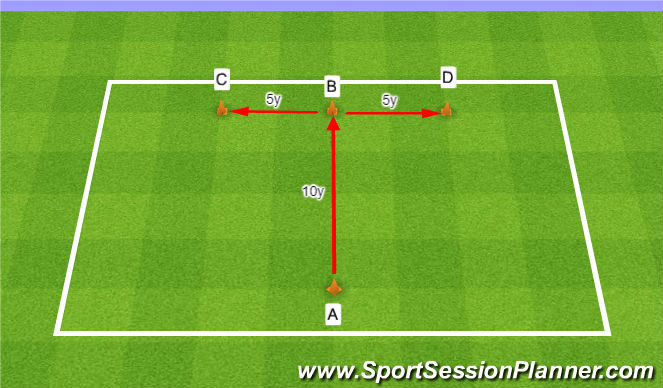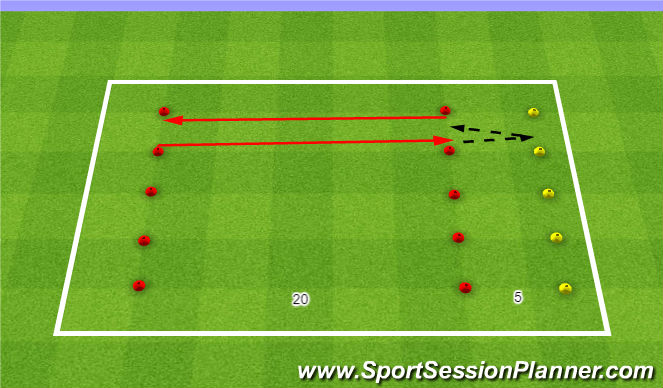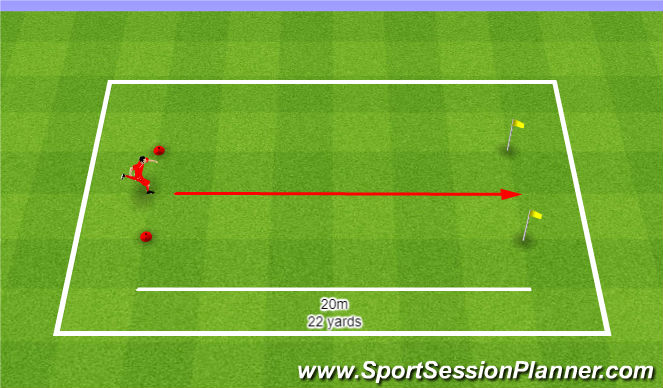Football/Soccer Session (Academy Sessions): Fitness Tests

Profile Summary

| Name: | Oli Brittain |
|---|---|
| City: | SLC |
| Country: | United States of America |
| Membership: | Adult Member |
| Sport: | Football/Soccer |

See the guidance at the top of this page to understand why you are not seeing interactive Football/Soccer images.

T - Test
T- Test
Physical Development Area: Speed, Balance and Coordination.
Purpose: the T-Test is a test of agility for athletes, and includes forward, lateral, and backward running.
Equipment required: marking cones, stopwatch, timing gates (optional)
t test of agility
Procedure: Set out four cones as illustrated in the diagram above (5 yards = 4.57 m, 10 yards = 9.14 m). The subject starts at cone A. On the command of the timer, the subject sprints to cone B and touches the base of the cone with their right hand. They then turn left and shuffle sideways to cone C, and also touches its base, this time with their left hand. Then shuffling sideways to the right to cone D and touching the base with the right hand. They then shuffle back to cone B touching with the left hand, and run backwards to cone A. The stopwatch is stopped as they pass cone A.
Reliability: the type of surface that is used should be consistent to ensure good test-retest reliability
Scoring: The trial will not be counted if the subject crosses one foot in front of the other while shuffling, fails to touch the base of the cones, or fails to face forward throughout the test. Take the best time of two successful trials to the nearest 0.1 seconds.

See the guidance at the top of this page to understand why you are not seeing interactive Football/Soccer images.

YoYo Test
YoYo Test
Physical Development Area: Endurance
Purpose: The test evaluates an individual's ability to repeatedly perform intervals over a prolonged period of time.
Equipment required: Flat, non-slip surface, marking cones, pre-recorded audio cd or mp3 Bluetooth player, recording sheets.
yo-yo intermittent test
Procedure: Use cones to mark out three lines as per the diagram above; 20 meters and 2.5 (endurance test) or 5 meters (recovery test) apart. The subject starts on or behind the middle line, and begins running 20 m when instructed by the cd. This subject turns and returns to the starting point when signaled by the recorded beep. There is a active recovery period (5 and 10 seconds respectively for the endurance and recovery versions of the test) interjected between every 20 meter (out and back) shuttle, during which the subject must walk or jog around the other cone and return to the starting point. A warning is given when the subject does not complete a successful out and back shuttle in the allocated time, the subject is removed the next time they do not complete a successful shuttle.









 Play animation
Play animation Play step-by-step
Play step-by-step Repeat (toggle)
Repeat (toggle) Full Screen
Full Screen Pause
Pause Stop
Stop
20m Sprint
20 Meter / 22 yard Sprint
Physical Development Area: Acceleration and Speed.
Purpose: The aim of this test is to determine acceleration, and also a reliable indicator of speed, agility and quickness.
Equipment required: Marked area, stopwatch or timing gates, cone markers, flat and clear surface of at least 30 meters.
Procedure: The test involves running a single maximum sprint over 20 meters, with the time recorded. A thorough warm up should be given, including some practice starts and accelerations. Start from a stationary position, with one foot in front of the other. The front foot must be on or behind the starting line. This starting position should be held for 2 seconds prior to starting, and no rocking movements are allowed. The tester should provide hints to maximizing speed (such as keeping low, driving hard with the arms and legs) and encouraged to continue running hard past the finish line.
Results: Two trials are allowed, and the best time is recorded to the nearest 2 decimal places. The timing starts from the first movement (if using a stopwatch) or when the timing system is triggered, and finishes when the chest crosses the finish line and/or the finishing timing gate is triggered.
Reliability: Reliability is greatly improved if timing gates are used. Also weather conditions and running surface can affect the results, and these conditions should be recorded with the results. If possible, set up the track with a crosswind to minimize the effect of wind.